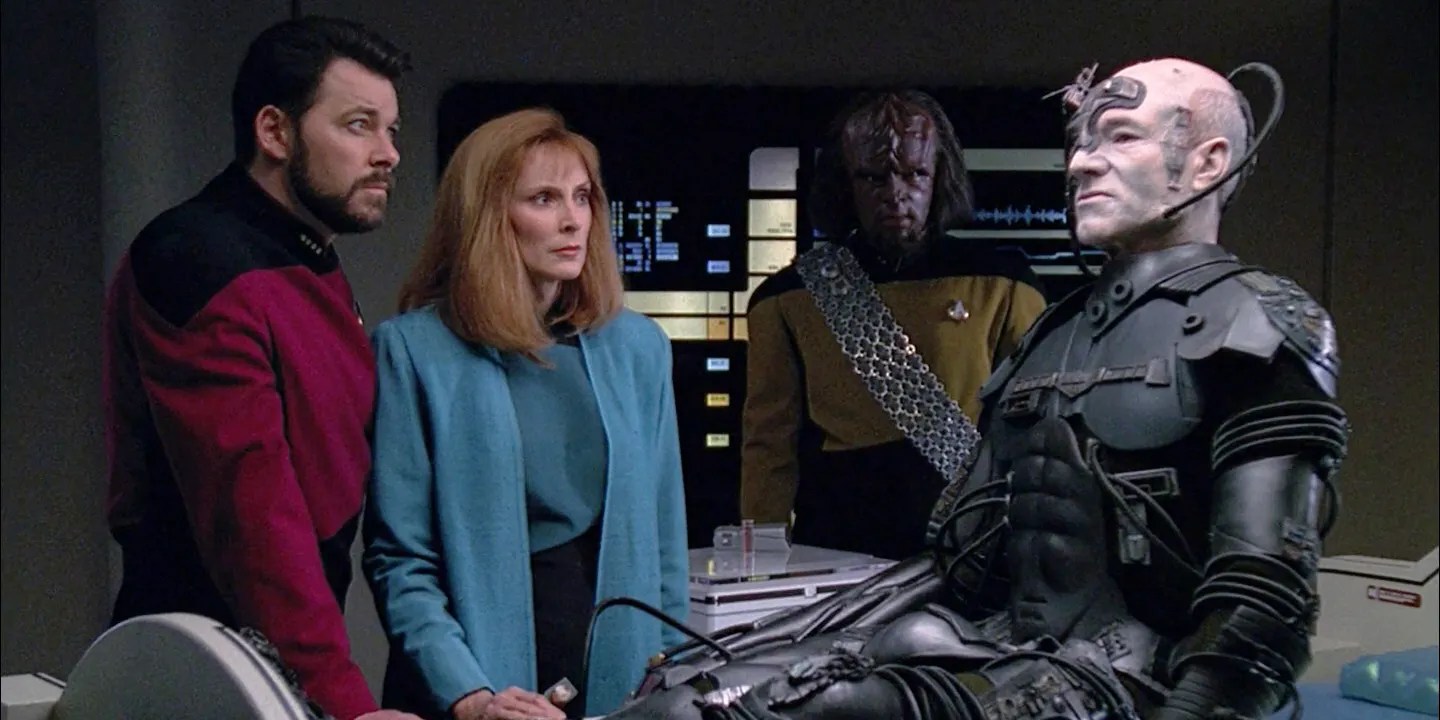Summary
Star Trek: The Next Generation’s legendary two-parter “The Best of Both Worlds” almost became something even bigger, according to a 1990 production memo that recently resurfaced. The episode’s high-stakes, edge-of-your-seat showdown between the Borg and the crew of the Enterprise-D was originally envisioned as a four-episode saga.
Long ranked as one of the most iconic stories in all ofTNG, “The Best of Both Worlds” aired as the two-part finale and premiere between Seasons 3 and 4. It not only solidifiedTNG’s legacy, but also helped define the modern cliffhanger. However, thanks to a fascinating behind-the-scenes nugget uncovered byThe Trek Collective, we now know that the creative team once considered an even grander scale for the story — a move that, had it happened, might have changed the trajectory ofStar Trekstorytelling forever.

ImaginingThe Next Generation’s Four-Part Saga
In 1990,two internal memos circulatedamong theTNGproduction staff: one from showrunner Michael Piller and another from writer Ronald D. Moore. Piller pitched a grander vision for a multi-part event, and Moore wholeheartedly agreed. Piller’s proposal was for a four-episode arc that dove deep into the ramifications of a Borg incursion. Moore supported the idea, even suggesting the Enterprise should be thoroughly beaten by the Borg, leaving Riker (Jonathan Frakes) to prove himself by pulling the ship back together and delaying their arrival at the Battle of Wolf 359. Moore stated his memo firmly:
“I am firmly in favor of a part three and four to the story.”

The story they imagined might have looked something like this:
What we got instead was similar, and still epic, but far more condensed. The two-part version delivers the essentials: Riker’s command dilemma, the introduction of Locutus, the dramatic cliffhanger, and theeventual self-destruction of the Borg cube. But several ambitious threads — like the broader Federation response, extended crew development, and Picard’s slow recovery — were largely left out or deferred to later episodes like “Family.”
Why TheStar Trek: TNGMega Episode Didn’t Happen
Ultimately, the four-parter never became a reality, largely due to executive producer Rick Berman. Berman had astrong preference for self-contained episodes, particularly those that could function as bottle shows — contained stories that typically returned to the status quo by the end. This was part of a broader production philosophy that aimed to makeTNGepisodes more accessible for syndication, where serialized storytelling was still considered a risky bet.
Michael Piller originally floated the idea of a trilogy, but Berman, along withseries creator Gene Roddenberry, leaned toward a science-based storyline that would remain mostly ship-bound and episodic in nature. They were wary of venturing too far into serialized territory, especially with such an effects-heavy adversary as the Borg.

There were likely other factors too. Budget constraints were significant — the elaborate sets, prosthetics, and visual effects required to convincingly depict a Borg War would have pushed the limits ofTNG’s resources. Time pressures were another issue. With a full slate of episodes already in motion for Season 3, it’s possible the team simply didn’t have the bandwidth to commit to a three or four-hour mega-episode.
Despite these obstacles, the pitches from Piller and Moore clearly influenced the final product. Though scaled back, the ambition of the proposed story bled through in the emotional weight and high-stakes tension that made “The Best of Both Worlds” unforgettable.

What Could Have Been: Expanded Arcs For Riker and Picard
The proposed four-part episode wouldn’t have just amped up the scale — it would have shaped the emotional and developmental arcs of theTNGcast in meaningful ways. Extending the Borg storyline across four parts would have given the characters more space to evolve and react to the Federation’s gravest threat yet. Ronald D. Moore saw the arc as a chance to stretch the characters and inject new life into the series:
“Watching us take the first hits, fall back, regroup, and ultimately push the Borg back will be an exciting series of stories.”

Captain Picard would have had a longer and more harrowing psychological journey as Locutus. Rather than a swift transformation and recovery, viewers might have seen Picard grappling with identity loss in real time. His trauma wouldn’t have been a footnote —it would have been front and center.
Commander Riker, too, would have grown immensely. A longer command arc would have given him the chance to truly step into the captain’s chair not as a reluctant placeholder, but as a decisive leader in wartime. Moore believed this extended scenario would help define Riker’s character more clearly, allowing viewers to see him command through adversity, rebuild the ship, and make high-stakes decisions that would ripple into later seasons. Piller and Moore viewed this as an opportunity to “take the show into new territory.” A four-part saga would have made Season 4 feel like a bold new chapter, and even set the stage for more serialized storytelling in the franchise.
“The Best of Both Worlds” Is StillStar TrekGold
But even as a two-parter, “The Best of Both Worlds” delivered one of the most dramatic moments in sci-fi television. Riker’s “Mr. Worf, fire” cliffhanger is legendary. The eerie calm of Locutus was spine-chilling. And the visual effects were ahead of their time. In fact, the impact was so profound that it still became a template for futureStar Trekseries and countless other TV shows. Without “The Best of Both Worlds,” there might be noDeep Space NineDominion War arc, and noVoyagerYear of Hell.
More than three decades later, the episode is still a benchmark. Newer series likeStar Trek: Picardhave echoed the themes of identity, trauma, and resilience first touched on here. And many fans think thisTNGstoryline is where we first truly saw the human side of stoic Jean-Luc Picard. The old memos that detail “The Best of Both Worlds” as a four-parter are a tantalizing glimpse into whatStar Trek: TNGmight have become if it hadembraced longer-form storytelling earlier. It’s a compelling reminder that even the roads not taken can still inspire fans and creators decades later.